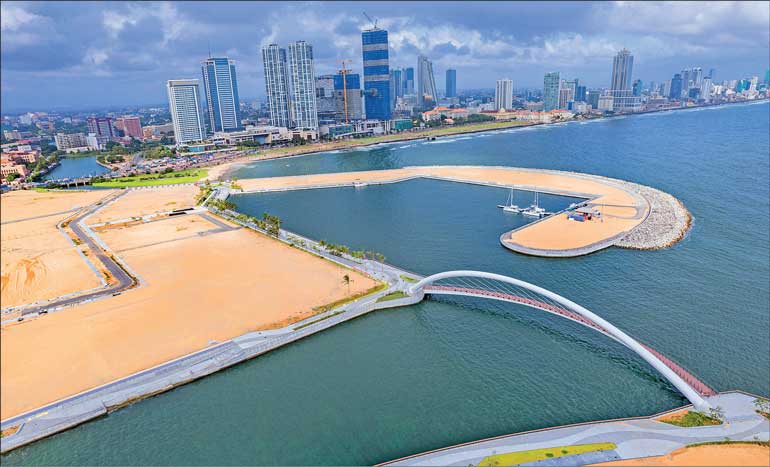Wednesday Jan 07, 2026
Wednesday Jan 07, 2026
Thursday, 14 July 2022 00:10 - - {{hitsCtrl.values.hits}}

Port City is nearing infrastructure development operations, and thereby may soon enable the financial services sector to provide significant improvement to the country’s economy
 Sri Lanka has traditionally been considered a country of smiling people, but presently many difficulties have been imposed and the ordinary people are trying to make the best of a difficult period.
Sri Lanka has traditionally been considered a country of smiling people, but presently many difficulties have been imposed and the ordinary people are trying to make the best of a difficult period.
From an examination of fundamentals, Sri Lankan society and the economy are in reasonable shape. A bubble economy may have developed due to excess liquidity in monetary flows. This may call for a careful implementation of monetary and fiscal policy. Urgent action is however required for securing bridging finance for the country’s balance of payment deficits and/or obtaining petroleum, from leaders of the gulf states through personal requests. The existing grave danger is the inflationary pressures could feed on itself, in the country’s economy. Although acute questions need answers in the short term, keeping an eye on the long term vision for the country requires high priority.
Attempting to understand the complexities of a path to development, Japan experience could be an example for providing insights as to how transition to an advanced society could take place.
Japan prior to the 1860s was a simple agrarian society. The imposition by the USA of unequal trade treaties at this time led to the realignment of society within Japan, and the restoration of the Meiji Emperor. During this period of change, Japan’s political leadership understood and accepted the need for obtaining from major nations, new institutional formats and technology. Emissaries were carefully selected and sent to these developed nations. The needed feedback information was obtained and the required changes effected over a period of time. Resultantly in Japan’s economy, land-reform was introduced, banking and enterprise laws were enacted to sustain and reinforce development activities. The start of the Zaibatsu companies are from this period. The Zaibatsu Firms were the giants of the economy, and a majority of the remaining, were SME or micro firms.
The consolidation of development generally took place through “administrative guidance” provided by the state sector, through sectoral public-private joint committees. Implementation by “consensus” was mostly achieved, Most administrators, both in public-private organisations are graduates from Japan’s universities and share common concerns. Also, it must be mentioned that Japanese products gained worldwide acceptance after export standards were enforced in respective sectors and price cartels were abolished by law.
At the same time Korea’s experience of sustained development would also be instructive for understanding how the “initiating” of development could take place. In the early 1970s Korea’s President Park implemented a comprehensive study of development systems of selected countries, and set about providing an organisational framework to facilitate trade and development.
The main growth engine for development was through subsidised investment funds being made available to chaebol companies for investment in selected sectors. In a manner similar to Japan, the Korean state promoted trade and investment through interlocking institutional arrangements. By ensuring agile entrepreneurship, the Korean chaebols duplicated the performance of the former Zaibatsu companies in most aspects of development. In consequence the “lift-off “of Korean economy was made possible by the support provided by the state and the availability of
funds for investment.
In Sri Lanka an organised program of development activities had also taken place in the early 1990s under the administration of President Premadasa. The development activities included schemes for investment funds for garment industry, initiation of industrial parks in diverse areas, housing developments and initiating methodologies for export promotion. These formative strategies provided a “push-start” for development. However, methodical sustainability of the programs did not take place.
Presently, in Sri Lanka, the IT sector has had significant success in expanding activities. The five-year development plan of SLASSCOM, the industry coordinating body, has enabled systematic progress to be made possible. The planning methodology of the sector is a good indicator of how activities of other respective sectors require to be planned and carefully implemented.
For any sectoral program of development to be methodically implemented over an extended period of time, the periodic reviewing of results is crucial. In consequence a dedicated coordinating body may need to be established under the close purview of key high officials. The underlying principle is that if unanimity of purpose could be established, success in implementation may be more forthcoming.
In order that a brief overview of the potential for development be provided, the economy of the country could be categorised into three broad groups. These are,
1. The services sectors: The functional divisions could include:
a) Tourism
b) IT services
c) Financial services
d) Ports and logistics services
e) Health services
f) Educational services
g) Construction services
2. Industrial activities sectors
3. Agriculture and fisheries sectors
When assessing sectorial potentials separately, it can be seen that the services sector of the economy if prioritised could deliver early success in development. In this regard tourism, IT services, ports and logistic services stand ready for significant progress. Similarly the Port City is nearing infrastructure development operations, and thereby may soon enable the financial services sector to provide significant improvement to the country’s economy.
The significance of the services sectors to the economy, could be readily understood when examining the balance of payments crisis of Britain in the mid 1980s. Britain’s economy was undergoing a painful decline of its industrial exports with large companies retrenching staff and labour unions imploding. However the London financial market commenced the establishment as a Centre for “euro-dollars” at about this time. Subsequently, the financial services sector dominated Britain’s economy.
When considering the potential for development of the industrial sectors of the economy, national strategic priorities need to be considered so as to ensure balanced growth to take place. Consequently, the natural resources available in the country, the technology development expectations, ecological issues, etc. may require to be filtered in. The principle of value addition may need to underpin project developments. Additionally, new methodologies for organising SME companies, in a manner similar to that done in some sectors of the German industry may be beneficial.
For development of the agriculture and the fisheries sectors, respective development plans may require formulation, after careful consideration of existing bottlenecks which require to be overcome. Increasing agricultural productivity may be critical for ensuring progress. The possible formation of model farms in differing agro climatic zones and the establishment of respective “associations of producers” in these areas, serviced by IT connectivity may be significant. This could facilitate supply chain linkages and the coordination of required inputs and outputs.
Similarly in the fisheries sector, the formulation of a sector development plan would enable the continued integrity of the infrastructure requirements of the industry and also facilitate supply chain linkages.
Presently especially in the livestock farming sector a major disruption of supply chain linkages has occurred. The absence of a planned program for ensuring supply arrangements may eventually result in a significant cutback of the industry.
After considering the above factors, in the final analysis for seeking a path for national development, it may be necessary to give careful consideration to a methodology to provide the selection and skills development of the country’s political executive and administration officials. In this respect one could find a relevant example in the Singapore experience. The stability of Singapore has enabled the country to implement a skills development program for the executive and administration leaders, together with a “mentoring” program of training for key assignments in the state sector. This program has enabled the “stability of succession” to take place. The understanding, and appropriate implementation of a similar system in Sri Lanka, over the long term, may help to avoid sudden discontinuities, on key policy issues.
Eventually in the long-term, stability rests in a large measure, on the integrity and transparency provided for in the country’s institutional framework and carried forward by those in high office in the respective institutions.
We as a nation have arrived at a critical juncture in our history, and require the appreciation of the complexity of the problems. Consequently, the implementation of corrective measures needs to be done, no matter how difficult; to save our common heritage as a simple, authentic, smiling nation.
The writer formerly worked at the Ministry of Planning, and has a MBA educational background from the United States.